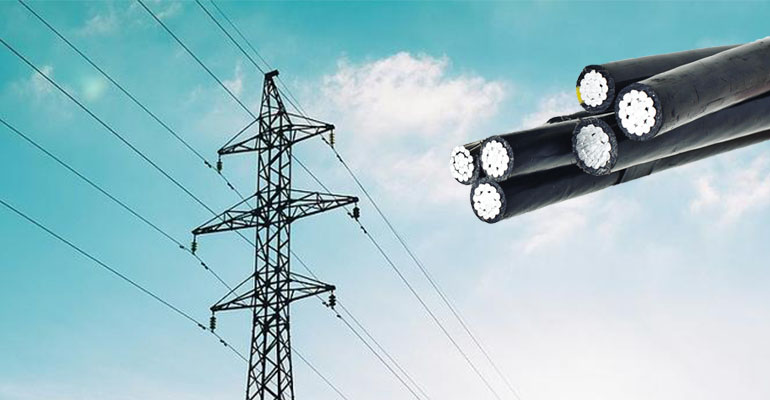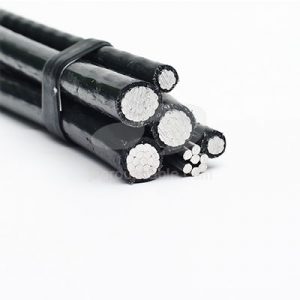- Offices Time:24 Hours Online
- Email:[email protected]
- WhatsApp:+8618339938759

Posted on December 21, 2022
Where are 10kV overhead insulated conductors used?
Overhead insulated conductors have the main characteristics of high power supply reliability, good power supply security, convenient erection and maintenance, and reasonable economy. Its main technical parameters include weather resistance, insulation level, inner and outer semi-conductive shielding layers. Aerial cables are widely used in power transmission at home and abroad. We have analyzed before what is an overhead insulated wire? Let’s learn more about it today!
Where are 10kV overhead insulated conductors used?
1.Suitable for places with many trees. For lines erected with bare wires, in areas with many trees, the erection and maintenance of the lines often have great conflicts with greening and forestry. The use of overhead insulated wires can reduce the felling of trees, solve many problems, and reduce the contradictions with greening, forestry and other departments, protect the ecological environment, beautify the city appearance, and reduce the grounding fault of the line.
2.It is suitable for areas with a lot of flying metal dust and pollution. In the old industrial area, metal processing enterprises often have metal dust flying in the wind due to environmental protection not up to standard. In the polluted areas of thermal power plants and chemical plants, short circuits and ground faults are caused in overhead power distribution lines. The use of overhead insulated conductors is a better way to prevent short-circuit grounding of 10kV distribution lines.

3.Suitable for salt spray areas. Salt spray corrodes the bare wires quite seriously, greatly reducing the tensile strength of the bare wires. When encountering wind and rain, the wires will break, causing short-circuit grounding accidents and shortening the service life of the wires. The use of overhead insulated wires can better prevent salt spray corrosion. Because there is a layer of insulating layer protection, it can reduce the corrosion of conductors by salt spray, delay the aging of lines, and prolong the service life of lines.
4.Suitable for areas with more lightning. Because the overhead insulated wire has a layer of insulation protection, it can reduce the lightning caused by the line. Even if there is lightning, the impact will be much smaller. For lines erected with bare conductors in minefields, the insulation of the lines generally declines rapidly, and burst grounding accidents often occur. After the overhead insulated conductor is replaced, the power outage time of the ground fault can be reduced.
5.It is suitable for the renovation of old urban areas. Since the overhead insulated conductor can withstand a voltage of 15kV, the vertical distance between the insulated conductor and the building is 1m, and the horizontal distance is 0.75m. Therefore, replacing the low-voltage trunk line with 10kV overhead insulated wires and directly feeding them into the load center to shorten the power supply radius of the low-voltage power grid is an effective power distribution method for old city renovation.
6.It is beneficial to prevent typhoon. Due to the poor typhoon resistance of the overhead bare conductor lines, once the typhoon arrives, the line trips one after another. After adopting overhead insulated wires, the momentary contact of the wires will not cause a short circuit, which reduces faults and greatly improves the typhoon resistance of the line

Problems that should be paid attention to when using 10kV overhead insulated wires:
1.The current carrying capacity of the insulated wire is larger than that of the bare wire, because the thermal resistance of polyethylene is lower than that of air, so adding the insulation layer to the bare wire is equivalent to increasing the surface area. When the heat dissipation conditions remain unchanged, the current carrying capacity is increased.
2.The regulations stipulate that the grounding point for power failure should be set. “On both sides of the contact switch, outside the branch rod, the tension rod joint, and on the wires of the branch line point that may reverse the power transmission, the power failure work grounding point should be set.” The grounding point should be as far as possible. Set on non-load-bearing conductors. Considering the influence of induced electricity and the convenience of maintenance, it is recommended to set up grounding points every 400m. Set a special grounding hook on the distribution transformer insulation down conductor.
3.The design regulations stipulate that the span of insulated overhead lines is limited, “the span of overhead insulated lines should not be greater than 50m.”
4.The regulations stipulate that the tight wire will break the wire. “Plastic pulleys or aluminum pulleys with rubber sheaths should be used. The diameter of the pulley should not be less than 12 times the outer diameter of the insulating wire, and the groove depth should not be less than 1.25 times the outer diameter of the insulating wire. The radius of the bottom of the groove is not less than 0.75 times the outer diameter of the insulated wire, and the inclination angle of the groove of the wheel groove is 15 °C. “The bending radius of the insulated wire is allowed to be greater than 20 times the outer diameter of the insulated wire, which should be possible during construction. In addition, the concentricity of the insulated wire is not good, and the wire will be broken during tight wire work.
Post categories
Most Popular Posts
-
The 136th Canton Fair welcomes you to participate!
October 12, 2024 -
High temperature cable introduction
July 26, 2024 -
Kenya Power and Energy Exhibition 2024
June 11, 2024 -
Introduction of rubber sheathed cable
June 5, 2024





